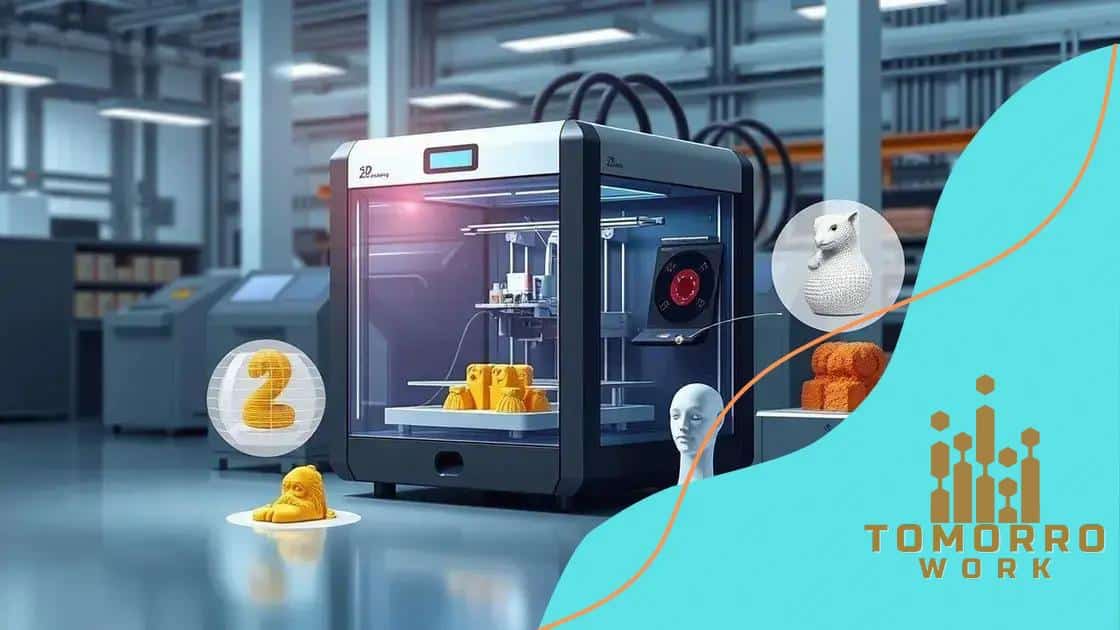The future of 3D printing in manufacturing industries

Advertisements
The future of 3D printing in manufacturing includes trends like AI integration, advanced materials, and sustainable practices, enhancing efficiency and customization across various industries.
The future of 3D printing in manufacturing industries is bright and full of opportunities. Have you ever wondered how this technology could transform production landscapes? Let’s delve into its potential.
Advertisements
Understanding 3D printing technology
Understanding 3D printing technology is essential for grasping its significance in modern manufacturing. This technology has revolutionized how products are designed and created, making it accessible to a broader range of industries.
What is 3D Printing?
3D printing, or additive manufacturing, is a process where three-dimensional objects are created from a digital file. This method involves layering materials until the final object is formed. It’s distinct from traditional subtractive manufacturing, as it builds objects rather than cutting away material.
Key Benefits
- Customization: Products can be tailored to specific needs and preferences.
- Reduced Waste: The additive process minimizes material waste compared to traditional methods.
- Speed: Prototypes can be produced more quickly, facilitating faster innovation.
- Complex Designs: Intricate designs that are difficult to produce with conventional methods can be easily created.
Another fascinating aspect of 3D printing is its ability to produce items on-demand. This means that manufacturers can create products as needed, reducing the need for large inventories. The flexibility of 3D printing allows for rapid alterations to designs without major costs. Customers can provide feedback, and adjustments can be made quickly.
Advertisements
In various industries—like aerospace, healthcare, and automotive—3D printing is implementing new standards in production. For instance, in healthcare, bespoke prosthetics and dental implants can be created with precision. The technology is not only improving customization but also enhancing patient outcomes.
Applications in Different Industries
Here are some industries utilizing 3D printing effectively:
- Aerospace: Lightweight components that enhance fuel efficiency.
- Automotive: Rapid prototyping of vehicle parts.
- Healthcare: Custom implants and surgical tools.
- Fashion: Unique clothing and accessory designs.
As you can see, the versatility of 3D printing technology opens doors to innovation. With advancements happening continuously, it’s an exciting time to be involved in this field. Understanding these developments allows businesses to stay competitive and responsive to market needs.
Impact of 3D printing on production efficiency
The impact of 3D printing on production efficiency is significant and drives innovations across various sectors. Implementing this technology can transform how goods are produced, resulting in time and cost savings.
Streamlining Production Processes
3D printing enables manufacturers to streamline their production processes. By allowing for rapid prototyping, companies can develop and test products faster than ever. This acceleration reduces the time to market, giving businesses a competitive edge.
Benefits of Additive Manufacturing
- Less Labor Intensive: Automated 3D printing reduces the need for manual labor, decreasing operational costs.
- Material Efficiency: The additive nature of 3D printing minimizes waste, making best use of the raw materials.
- Rapid Iteration: Adjustments can be made quickly without significant setup time.
- Inventory Reduction: On-demand production means less inventory is required, freeing up capital.
As we see, 3D printing revolutionizes not just product creation but also configurations within manufacturing processes. It supports the creation of complex designs that traditional methods struggle to achieve, leading to improved product performance.
In industries such as automotive and aerospace, the adoption of 3D printing technology reflects a shift toward efficiency. For example, manufacturers can create lighter, stronger parts that enhance fuel efficiency. The ability to produce parts locally also cuts down on shipping and logistics costs, improving overall efficiency.
Challenges to Consider
While the advantages are clear, challenges exist. Companies must invest in training and technology. Often, initial costs can be high, and changes to established workflows are necessary. However, the long-term gains in efficiency frequently outweigh these initial hurdles.
In conclusion, the impact of 3D printing on production efficiency highlights a paradigm shift in the manufacturing landscape. With continually growing capabilities, it positions businesses for future demands and innovations.
Custom manufacturing with 3D printing

Custom manufacturing with 3D printing is changing how products are made. This process allows for unique designs that meet specific needs of customers and industries. Unlike traditional manufacturing, 3D printing can create one-of-a-kind items without massive investments in tooling.
The Advantages of Custom Manufacturing
One of the main benefits of custom manufacturing is personalization. Customers can influence the design and functionality of products. This approach leads to improved customer satisfaction because products can meet exact requirements.
Applications of Custom Manufacturing
- Aerospace: Lightweight, custom parts reduce fuel consumption.
- Healthcare: Personalized implants and prosthetics fit better and enhance recovery.
- Consumer Products: Unique designs for gadgets and accessories attract niche markets.
- Automotive: Tailored components improve vehicle performance and aesthetics.
Furthermore, the speed at which custom designs can be produced is remarkable. A digital file can be transformed into a physical object in hours instead of weeks. This rapid turnaround supports innovation and allows companies to respond quickly to market demands.
Another aspect of custom manufacturing is its impact on sustainability. Traditional manufacturing often leads to significant waste. In contrast, 3D printing uses only the necessary material needed for the final product, cutting down on waste and promoting a more eco-friendly approach to production.
Challenges in Custom Manufacturing
Despite its many benefits, custom manufacturing with 3D printing faces challenges. Not all materials are suitable for 3D printing, and the technology can be costly. Companies must also ensure they have the right skills to design and operate 3D printers effectively. However, as technology improves, these challenges are beginning to diminish.
In summary, the rise of custom manufacturing with 3D printing is reshaping the landscape of various industries. This method not only meets consumer demands for personalized products but also encourages innovation and sustainability in manufacturing.
Sustainability benefits of 3D printing
The sustainability benefits of 3D printing are becoming increasingly important in today’s environmentally conscious world. This technology offers innovative solutions that can reduce waste and energy consumption in manufacturing processes.
Reduced Material Waste
One major advantage of 3D printing is its ability to create objects layer by layer. This additive process minimizes excess material usage, unlike traditional subtractive manufacturing, which often results in significant waste. By only using the necessary materials, 3D printing supports a more sustainable approach to production.
Energy Efficiency
- Lower Energy Consumption: 3D printing can require less energy than traditional methods.
- Local Production: Items can be produced closer to the point of use, which reduces transportation emissions.
- Efficient Design: Designs can be optimized for less energy during production.
Moreover, since 3D printing can produce parts on-demand, it reduces the need for large inventories. This not only cuts down on storage needs but also leads to lower overhead costs. As companies shift to just-in-time manufacturing, they can further enhance their sustainability efforts.
The technology also opens up possibilities for using recycled materials in the 3D printing process. Many companies are now exploring ways to incorporate biodegradable plastics and other sustainable materials into their production, reducing dependency on new raw materials.
Impact on Product Lifecycles
3D printing can extend the lifecycle of products. For instance, instead of disposing of broken items, businesses can simply print replacement parts. This capability not only reduces waste but also contributes to a circular economy, where products are reused and repurposed effectively.
Investing in sustainable 3D printing technology is not just an opportunity for companies; it is also essential for meeting consumer demands. Many consumers today prefer brands that prioritize eco-friendly practices. By adopting 3D printing, manufacturers can position themselves as leaders in sustainability while attracting environmentally conscious customers.
Emerging trends in 3D printing
Emerging trends in 3D printing are shaping the future of manufacturing and design. As this technology advances, it opens up new possibilities across various industries, leading to innovative applications and increased efficiency.
Integration of Artificial Intelligence
One of the most exciting trends is the integration of artificial intelligence (AI) with 3D printing. AI can optimize printer settings and enhance design processes by analyzing data from previous prints. This leads to improved accuracy and faster production times.
Advanced Materials
- Biodegradable Plastics: Materials that break down naturally are becoming more popular.
- Metal 3D Printing: The ability to use metals is growing, allowing for stronger and lighter components.
- Flexible Filaments: Materials that can bend and stretch enable new design possibilities.
- Composite Materials: Combining various materials offers unique properties for specialized applications.
In addition, the development of new materials specifically designed for 3D printing enhances the capabilities of this technology. For instance, 3D printing is now being used to create lighter and more durable components in industries such as aerospace and automotive.
Another trend is the use of 3D printing in construction. Large-scale 3D printers are now being employed to create building structures and components. This method can significantly reduce construction time and costs while minimizing waste.
On-Demand Production
On-demand production is gaining traction as manufacturers recognize its benefits. This approach allows businesses to create products as needed, reducing inventory costs and waste. For example, companies can produce spare parts for machinery instantly rather than keeping a large stock.
As the demand for customization increases, 3D printing offers the flexibility needed to meet specific customer requirements. Customers are seeking personalized solutions, and 3D printing enables the rapid production of unique items tailored to individual preferences.
Education and Training
Finally, as 3D printing becomes more prevalent, educational programs are emerging to train the next generation of professionals. Schools and universities are incorporating 3D printing into their curricula, ensuring that students are equipped with the necessary skills to thrive in this evolving field.
FAQ – Frequently Asked Questions about 3D Printing
What are the sustainability benefits of 3D printing?
3D printing reduces material waste and energy consumption, as it uses only the necessary materials and can be produced on-demand.
How does 3D printing support customization?
3D printing allows for personalized designs tailored to individual customer preferences, making it easy to create unique products.
What are emerging trends in 3D printing?
Emerging trends include the integration of artificial intelligence, advanced materials, on-demand production, and new training programs for professionals.
How can 3D printing impact traditional manufacturing processes?
3D printing can streamline production by enabling rapid prototyping, reducing lead times, and minimizing inventory costs.





